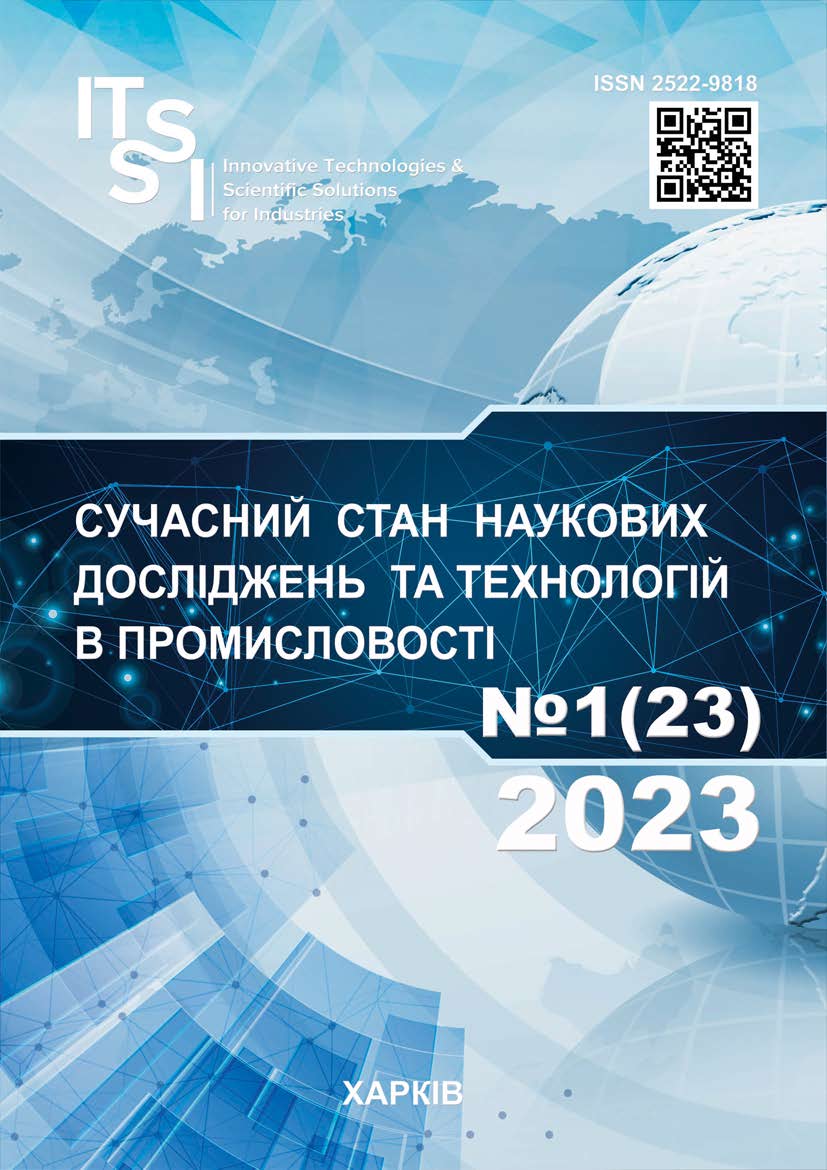СТРУКТУРНА МОДЕЛЬ ІННОВАЦІЙНО-ІНЖИНІРИНГОВОГО ПРОМИСЛОВОГО КЛАСТЕРУ Й АЛГОРИТМ ЙОГО ФОРМУВАННЯ
DOI:
https://doi.org/10.30837/ITSSI.2023.23.005Ключові слова:
інноваційно-інжиніринговий промисловий кластер; синергетичний регіональний ефект; факторний аналіз; кластерний аналізАнотація
Предметом дослідження є використання промислових кластерів як інструментів для інноваційного зростання економіки. Мета статті – розроблення структурної, економіко-математичної моделі формування промислового кластеру та створення алгоритму кластерного зонування економіки. Завдання, що вирішуються: аналіз принципів інноваційного зростання; розроблення моделі інноваційно-інжинірингового промислового кластеру; опис методики формування регіонального інноваційно-інжинірингового кластеру; аналіз і оцінювання ознак, що виникають у кластерів; використання кластерного аналізу для систематизації, класифікації та зменшення кількості ознак. Застосовані методи: системний аналіз, проєктний підхід, інстуціональна теорія, методи кластеризації, критерій сферичності Бартлетта та критерій адекватності вибірки Кайзера-Меєра-Олкіна, багатофакторний регресійний аналіз, F-критерій Фішера. Здобуті результати: визначено, що найкращим підходом до об’єднання основних складників інноваційного становлення, а саме державних органів, бізнесу та інститутів розвитку, є створення інноваційно-інжинірингових кластерів. Описано принципи створення та функціонування зазначених кластерів. Показано, що в основі алгоритму кластерної побудови регіонів лежить інтеграція кількісних і якісних методів ідентифікації та кластеризації економіки. Це дає змогу, на відміну від наявних підходів, не тільки ідентифікувати елементи кластеру, а й змоделювати рівні взаємодії між ними. Для оцінювання ефективності роботи кластеру запропоновано застосовувати синергетичний ефект від використання новоутвореної структури. Висновки: застосування регіональних інноваційно-інжинірингових кластерів дає змогу сформувати ефективну стратегію розвитку економіки регіону. Розроблений алгоритм кластерного зонування інтегрує кількісні та якісні методи визначення можливостей кластеризації економіки регіону. Комплексна взаємодія економіко-політичних чинників призводить до синергетичного ефекту й дає змогу моделювати кластерне утворення з виявленням складу учасників і рівня взаємодії між ними.
Посилання
References
Shevchuk, S. (2011). Definition of the concept of innovative economy. Formation of market relations in Ukraine. 2011. No. 1. P. 83–86. URL: http://nbuv.gov.ua/UJRN/frvu_2011_1_21
Balanchuk, I.S., Mykhalchenkova, O.E. (2021). Technological platforms in the sphere of innovations – trends in Europe and Ukraine. Science, technologies, innovations. Р. 14–24. DOI: http://doi.org/10.35668/2520-6524-2021-2-03
Fedirko O.A. (2015). European technological platforms as a mechanism of sectoral innovative development of the EU / Scientific Bulletin of the International Humanitarian University. URL: https://ir.kneu.edu.ua/bitstream/handle/2010/33371/Nvmgu_eim_2015_14_10.pdf
Voynarenko M. (2014). Clusters in the economy of Ukraine: monograph / Khmelnytskyi: KNU. 1085 р.
Jolliffe I.T. (2002) Principal Component Analysis, Series: Springer Series in Statistics, 2nd ed., Springer, NY, XXIX. 487 p. URL: http://cda.psych.uiuc.edu/statistical_learning_course/Jolliffe%20I.%20Principal%20Component%20Analysis%20(2ed.,%20Springer,%202002)(518s)_MVsa_.pdf
Akhiezer E.B. (1996). The calculation of correlation matrices of some random processes. Materials of international scientific-technical conference "Information ion technology: science, engineering, technology, education, health". – Kharkov. P. 15–17.
Zhernova P., Bodyanskiy Ye. (2018). Kernel fuzzy clustering of data streams based on the ensemble of neural networks. Innovative technologies and scientific solutions for industries. – № 4 (6). P. 50–56. DOI: https://doi.org/10.30837/
-9818.2018.6.042
Ryneiska L. S. Klastery u suchasnii hlobalnii ekonomitsi [Clusters in today’s global economy]. URL: http://www.economy.nayka.com.ua
Kor
obova M., Lyashenko I., Stolyar A. (2006). Fundamentals of mathematical modeling of economic, ecological and social processes / Educational book – Bohdan, 304 р. URL: https://book-ye.com.ua/upload/iblock/7d4/c7fbefb1_dca3_11e6_80c1_000c29ae1566_b5448ce9_873d_11e7_80cf_000c29ae1566.pdf
Reshetnyak, O. (2020). Modeling rating of scientific and technological development of the countries. Innovative technologies and scientific solutions for industries. – 2020. № 1 (11). Р. 80–89. DOI: https://doi.org/10.30837/2522-9818.2020.11.080
Pryimak V. (2019). Mathematical methods of economic analysis // K. Center of educational literature. 296 р.
Dunaevskaya I. (2008). Multistage clustering in the traveling salesman problem of high dimension / O.V. Gray, I. Dunaevskaya // East European journal of advanced technologies. No. 5/5. P. 54–56.
Kostenko U. T., Ruskin L. G. (1996). Forecasting technical condition control systems. – Kharkov: The Foundation. 303 p.
Ivakhnenko A. G. (1975) Long-term prediction and control of complex systems. – Kyiv: Tekhnika. 311 p.
Bibik N., Shapoval G. (2019) An analysis of international experience of the development of territorial communities and the determination of the directions of its implementation in Ukraine. Innovative technologies and scientific solutions for industries, № 2 (8).
Р. 5–71. DOI: https://doi.org/10.30837/2522-9818.2019.8.005
##submission.downloads##
Опубліковано
Як цитувати
Номер
Розділ
Ліцензія
Авторське право (c) 2023 Олена Ахієзер , Ольга Дунаєвська , Антон Роговий , Галина Голотайстрова , Юрій Решетняк , Сергій Мехович

Ця робота ліцензується відповідно до Creative Commons Attribution-NonCommercial-ShareAlike 4.0 International License.
Наше видання використовує положення про авторські права Creative Commons для журналів відкритого доступу.
Автори, які публікуються у цьому журналі, погоджуються з наступними умовами:
Автори залишають за собою право на авторство своєї роботи та передають журналу право першої публікації цієї роботи на умовах ліцензії Creative Commons Attribution-NonCommercial-ShareAlike 4.0 International License (CC BY-NC-SA 4.0), котра дозволяє іншим особам вільно розповсюджувати опубліковану роботу з обов'язковим посиланням на авторів оригінальної роботи та першу публікацію роботи у цьому журналі.
Автори мають право укладати самостійні додаткові угоди щодо не комерційного та не ексклюзивного розповсюдження роботи у тому вигляді, в якому вона була опублікована цим журналом (наприклад, розміщувати роботу в електронному сховищі установи або публікувати у складі монографії), за умови збереження посилання на першу публікацію роботи у цьому журналі.
Політика журналу дозволяє і заохочує розміщення авторами в мережі Інтернет (наприклад, у сховищах установ або на особистих веб-сайтах) рукопису опублікованої роботи, оскільки це сприяє виникненню продуктивної наукової дискусії та позитивно позначається на оперативності та динаміці цитування опублікованої роботи.














